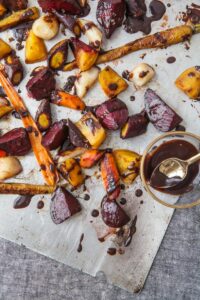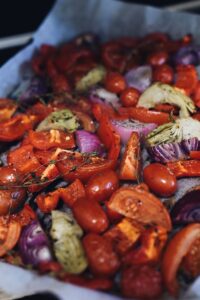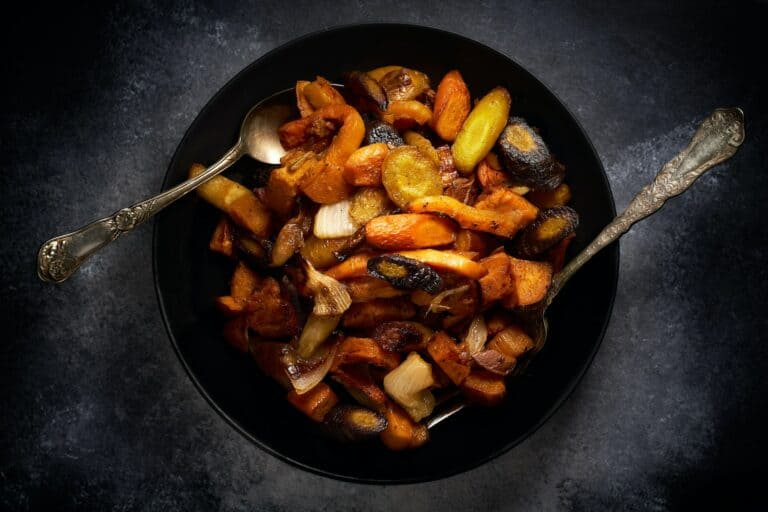There’s something incredibly satisfying about a warm, hearty bowl of vegetable soup on a chilly day. But have you ever tried adding roasted vegetables to your soup? Roasting vegetables not only enhances their natural flavors but also adds a rich texture and increased nutritional value to your soup. In this blog post, we’ll explore the world of roast vegetables for soup, discuss the best vegetables to use, and share a delicious roasted vegetable soup recipe that you can make at home.
Selecting and Preparing Vegetables for Roasting

To create a delicious roasted vegetable soup, it’s essential to choose the right vegetables. Some of the best vegetables to roast for soup include:
1. Root vegetables (e.g., carrots, potatoes, sweet potatoes)
2. Squash (e.g., butternut, acorn)
3. Onions and garlic
4. Tomatoes and bell peppers
5. Cruciferous vegetables (e.g., cauliflower, broccoli)
When selecting vegetables, look for fresh, high-quality produce. Preparing the vegetables for roasting involves washing and peeling (if necessary), cutting them into even-sized pieces, and tossing them in oil and seasoning.
Roasting Techniques and Tips
The key to perfectly roasted vegetables is choosing the right oil. Olive oil is a popular choice for roasting vegetables, as it adds a rich flavor and has a reasonably high smoke point. However, other high smoke point oils such as vegetable oil, canola oil, or avocado oil are also suitable.
Season your vegetables with simple salt and pepper or experiment with different herbs, spices, and specialty seasoning blends to create unique flavor profiles. We recommend roasting your vegetables at a temperature of 400°F (200°C) to 425°F (220°C) for even cooking and caramelization. Roasting time will vary depending on the type and size of the vegetables, so keep an eye on them and test for tenderness with a fork.
To ensure even roasting, avoid overcrowding the pan and stir or flip the vegetables halfway through the cooking time. Using two sheet pans can also help prevent overcrowding and ensure a single layer of vegetables on each pan.
Turning Roast Vegetables into Soup

Once your vegetables are roasted to perfection, it’s time to turn them into a delicious roasted veggie soup. First, choose a base for your soup. Vegetable or chicken stock is a popular choice and keeps the soup light, while cream or milk can be added for a richer, creamier texture.
Blend the roasted vegetables using an immersion blender, standard blender, or food processor. Adjust the blending time to achieve a smooth or chunky texture, depending on your preference. Next, add additional flavor elements, such as fresh herbs, spices, seasonings, or acidic elements like lemon juice or vinegar. Adjust the consistency of your soup by adding more broth, water, or cream as needed. Finally, taste your soup and adjust the seasoning with salt and pepper to taste.
Serving Ideas and Accompaniments
A beautiful garnish can elevate your roasted vegetable soup to the next level. Consider topping your soup with a swirl of cream or yogurt, a sprinkle of toasted nuts or seeds, or a few fresh thyme leaves.
Accompany your soup with a crusty bread, a grilled cheese sandwich, or a simple green salad for a complete and satisfying meal. If you’re in the mood for a side dish, try pairing your soup with a delicious gluten-free option like roasted sweet potato or red bell pepper.
A Roasted Vegetable Soup Recipe to Try
Now that you’re familiar with the basics of roast vegetables for soup, it’s time to try your hand at a tasty recipe. This roasted vegetable soup recipe is absolutely delicious, nutritious, and perfect for meal prep or a cozy dinner at home.
Ingredients:
– 2 large carrots, roughly chopped
– 1 large sweet potato, roughly chopped
– 1 butternut squash, peeled, seeded, and roughly chopped
– 1 red bell pepper, roughly chopped
– 1 large red onion, roughly chopped
– 4 garlic cloves, peeled
– 3 tablespoons olive oil
– Salt and pepper to taste
– 4 cups vegetable stock (or chicken stock for a non-vegetarian option)
– 1 can diced tomatoes, drained
– 1 can coconut milk
– 1 teaspoon fresh thyme leaves
– Optional garnishes: fresh thyme, a swirl of coconut milk, toasted nuts or seeds
Instructions:
1. Preheat the oven to 425°F (220°C). Place the chopped vegetables and garlic cloves on a large baking tray lined with parchment paper. Drizzle with olive oil, and season with salt and pepper. Toss to coat the vegetables evenly.
2. Roast the vegetables in the preheated oven for 25-30 minutes, or until they are tender and slightly caramelized. Remove from the oven and let them cool slightly.
3. In a large pot, heat 1 tablespoon of olive oil over medium heat. Add the roasted vegetables and saute for 2-3 minutes, until they are heated through and slightly softened.
4. Add the vegetable stock (or chicken stock), diced tomatoes, and coconut milk to the pot. Stir to combine, and bring the mixture to a simmer.
5. Using an immersion blender (or carefully transferring the soup to a regular blender in batches), blend the soup to your desired consistency. If you prefer a chunkier soup, blend for a shorter time. For a smoother soup, blend longer.
6. Taste the soup and adjust the seasoning, adding salt and pepper as needed. Stir in the fresh thyme leaves and simmer for an additional 5-10 minutes.
7. Serve the soup warm, garnished with your choice of toppings. If you’re storing the soup for meal prep, let it cool completely before transferring it to airtight containers and storing it in the refrigerator.
Roasting Vegetables: A Culinary Delight

Roasting vegetables is a culinary technique that can transform the ordinary into the extraordinary. With just a few simple steps, you can elevate the flavors of your favorite veggies and create delectable dishes that will leave your taste buds dancing. In this section, we’ll delve deeper into the art of roasting vegetables and explore creative ways to incorporate them into various recipes.
Roasting Techniques and Flavor Enhancements
Roasting vegetables is all about coaxing out their natural sweetness and developing complex flavors. Here are some techniques and flavor enhancements to consider:
- High Heat Magic: Roasting at high temperatures, typically between 400°F (200°C) and 425°F (220°C), allows the vegetables to caramelize, resulting in a delightful sweetness and a crispy exterior. This caramelization is the secret to unlocking the vegetables’ full flavor potential.
- Seasoning Beyond Basics: While salt and pepper are excellent seasoning choices, don’t be afraid to get creative with your spice rack. Experiment with herbs like rosemary, thyme, or oregano, or add a kick with smoked paprika, cumin, or chili flakes. A touch of balsamic vinegar or honey can introduce delightful depth and complexity to the roasted vegetables.
- Texture Play: Consider the texture you want to achieve. For example, roasting vegetables until they are slightly charred and tender is perfect for side dishes or as a topping for salads. However, if you’re planning to use them in a soup or stew, a more substantial roast with a caramelized exterior is often preferred.
- Oil Selection: Choose your roasting oil wisely. While olive oil is a classic choice, oils like sesame, coconut, or even flavored oils can impart unique and delightful undertones to your roasted vegetables.
Innovative Recipes to Make with Roasted Vegetables
Now that you’ve mastered the art of roasting vegetables, it’s time to get creative in the kitchen. Here are two innovative recipes that showcase the versatility of roasted vegetables:
1. Roasted Vegetable Tacos with Creamy Avocado Dressing
Transform your roasted vegetables into a satisfying taco filling. Combine your roasted veggies with black beans, corn, and a medley of colorful bell peppers. Serve them in warm corn tortillas and drizzle with a luscious creamy avocado dressing. Top with fresh cilantro, a squeeze of lime, and crumbled queso fresco for a burst of flavor and texture.
2. Roasted Vegetable and Couscous Salad with Lemon-Tahini Dressing
Create a hearty salad with roasted vegetables as the star. Toss your roasted veggies with cooked couscous, cherry tomatoes, cucumber, and chopped fresh herbs. Drizzle with a zesty lemon-tahini dressing for a creamy and tangy finish. This salad makes for a wholesome lunch or a delightful side dish at your next barbecue.
Incorporating roasted vegetables into your recipes adds depth, flavor, and nutrition to your meals. Whether you’re crafting a taco filling or preparing a vibrant salad, roasting vegetables opens up a world of culinary possibilities that are sure to delight your palate and impress your guests. So, don’t hesitate to experiment with this cooking technique and let your creativity soar in the kitchen.
Unlocking Flavors with Baked Vegetables
When it comes to enhancing the flavors of vegetables for your soup, don’t limit yourself to roasting alone—baking is another culinary technique that can add a delightful twist. Baking vegetables involves a slower cooking process, allowing them to absorb flavors more thoroughly. Preparing a vegetable soup with baked veggies introduces a distinct depth that can elevate your culinary experience. Consider tossing carrots, zucchini, and cherry tomatoes with olive oil, salt, and pepper, then baking them at 375°F (190°C) until they develop a golden caramelization. The result is a medley of flavors that harmonize perfectly when transformed into a hearty vegetable soup.
For an easy and healthy baked vegetable soup recipe, try this: coat your favorite vegetables in olive oil, sprinkle them with your preferred herbs and spices, then bake until they are tender. Once baked to perfection, blend them with a wholesome broth, and you’ll have a comforting and nutrient-rich soup in no time. This easy-to-make recipe is not only a feast for the taste buds but also a convenient option for a quick, wholesome meal.
Soup Alchemy: Crafting Easy and Healthy Vegetable Blends
Creating a variety of vegetable soup recipes is a culinary adventure that allows you to experiment with different combinations of flavors and textures. Making an easy and healthy vegetable soup involves selecting a mix of colorful and nutrient-packed ingredients. Start with a base of broth, whether it’s vegetable or chicken, and add a medley of roasted and baked vegetables. The key is to strike a balance between simplicity and nutritional richness.
For an effortless yet wholesome vegetable soup recipe, try this: in a large pot, simmer a combination of roasted carrots, sweet potatoes, and bell peppers in a flavorful broth. The roasting process enhances their natural sweetness, while the broth infuses them with savory richness. Add some baked cauliflower for a satisfying texture. This easy-to-make recipe not only ensures a delicious outcome but also provides a healthy option for those looking to incorporate more veggies into their diet. The simplicity of this soup-making process allows you to experiment with various vegetables and discover your own signature recipe.
Beyond Basic: Elevating Your Vegetable Soup Repertoire
Take your vegetable soup game to the next level by exploring unique and innovative recipes. While classic roasted vegetable soup is undoubtedly a crowd-pleaser, incorporating diverse ingredients can turn your soup into a culinary masterpiece. Experiment with adding grains like quinoa or lentils for added protein and texture. Consider introducing unexpected elements such as a squeeze of lemon or a dash of your favorite hot sauce to create a personalized flavor profile. These additions not only contribute to the taste but also bring a touch of creativity to the table.
For a recipe that goes beyond the basics, try this: roast a mix of Brussels sprouts, parsnips, and cherry tomatoes until they achieve a perfect caramelization. Blend them with a broth infused with rosemary and thyme for an aromatic twist. Add cooked quinoa for a hearty finish. This easy and healthy recipe not only expands your vegetable soup repertoire but also offers a delightful combination of flavors and textures that will leave your palate satisfied. So, embrace the joy of experimenting in the kitchen and create vegetable soup recipes that reflect your unique culinary style.
Conclusion on Roast Vegetables for Soup
Roasted vegetable soup is a delicious and nutritious twist on a classic comfort food. By choosing the right vegetables, roasting them to perfection, and blending them into a flavorful soup, you’ll create a dish that quickly becomes one of your favorite soups. We hope this blog post has inspired you to try roast vegetables for soup and to experiment with different vegetables and flavor combinations. Don’t forget to share your favorite tasty recipes and experiences with us in the comments below! Happy cooking!
Other suggested articles:

